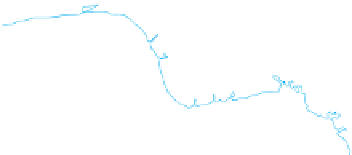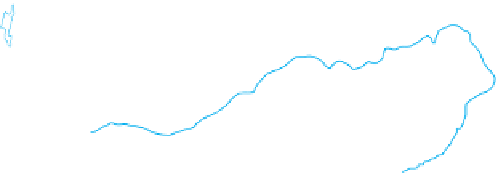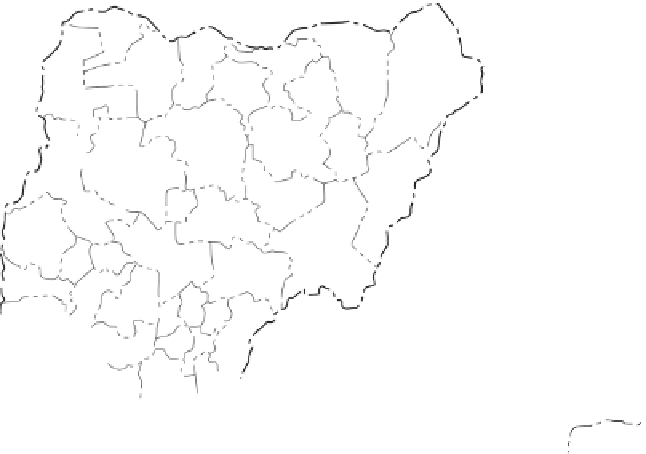Geography Reference
In-Depth Information
5°
10°
15°
NI
GER
SOKOTO
Lake
Chad
JIGAWA
ZAMFARA
YOBE
BORNO
BURKINA
FASO
KANO
CHAD
KEBBI
BAUCHI
KADUNA
10°
NIGER
10°
KWARA
FEDERAL
CAPITAL
TERRITORY
PLATEAU
NASSARAWA
Lagdo
Reservoir
OYO
TARABA
EKITI
OSUN
C
ENTRAL A
FRICAN
RE
PUBLIC
BENUE
15°
OGUN
EDO
ANAMBRA
Mbakaou
Reservoir
NIGERIAN STATES WITH
SHARI'A LAW
15°
LAGOS
IMO
ABIA
DELTA
Shari'a Law proclaimed
5°
5°
Figure 8.11
States in Nigeria with Shari'a Law.
Data
from:
BBC, http://news.bbc.co.uk/2/hi/africa/1962827
.stm#map.
AKWA
IBOM
BAYELSA
RIVERS
ATLANTIC
OCEAN
0
150
300 Kilometers
EQUATORIAL
GUINEA
0
100
200 Miles
Longitude East of Greenwich
10°
5°
in a weak federal system, the central government retains
a signifi cant measure of power. Most federal systems are
somewhere in between, with governments at the state
scale and at the substate scale each having control over
certain revenues and certain policy areas. Giving control
over certain policies (especially culturally relative policies)
to smaller-scale governments is one strategy for keeping
the state as a whole together.
Federalism functions differently depending on the
context. In Nigeria, the 36 constituent States choose their
own judicial system. In the Muslim north, twelve States
have Shari'a laws (legal systems based on traditional Islamic
laws), and in the Christian and animist south, the States do
not (Fig. 8.11). Shari'a law in the northern states of Nigeria
is only applied to Muslims, not to Christians and Animists.
The move to Shari'a law in the north came at the same time
as democracy swept Nigeria in 2000. Nigerians in the north
hoped stricter laws would help root out corruption among
politicians, although it has failed to do so.
In the United States, States take different approaches
to matters such as the death penalty, access to alcohol
(Fig. 8.12), and the right to carry concealed weapons but
many of the fundamentals of the legal system do not differ
among States.
Federalism accommodates regional interests by vest-
ing primary power in provinces, States, or other regional
units over all matters except those explicitly given to the
central government. The Australian geographer K. W.
Robinson described a federation as “the most geographi-
cally expressive of all political systems, based as it is on the
existence and accommodation of regional differences . . .
federation does not create unity out of diversity; rather, it
enables the two to coexist.”
Choosing a federal system does not always quell
nationalist sentiment. After all, the multinational states
of the Soviet Union, Yugoslavia, and Czechoslovakia fell
apart, despite their federalist systems, and the future of
Belgium as a single state is uncertain.
Devolution
Devolution
is the movement of power from the central
government to regional governments within the state.
Sometimes devolution is achieved by reworking a con-
stitution to establish a federal system that recognizes the
permanency of the regional governments, as Spain has
done. In other places, governments devolve power with-
out altering constitutions, almost as an experiment. In the
United Kingdom, the Northern Ireland Assembly, a par-
liamentary body, resulted from devolution, but the Brit-
ish government suspended its activities in 2002 and then
reinstated the assembly in 2007. Devolutionary forces can
emerge in all kinds of states, old and young, large and small.
These forces arise from several sources of internal division:
ethnocultural, economic, and territorial.
Ethnocultural Devolutionary Movements
Many of Europe's devolutionary movements came from
nations within a state that defi ne themselves as being eth-
nically, linguistically, or religiously distinct.
The capacity of ethnocultural forces to stimulate
devolutionary processes has been evident, for example, in
eastern Europe. Parts of the eastern European map have
changed quite drastically over the past two decades, and
two countries, Czechoslovakia and Yugoslavia, succumbed
to devolutionary pressures. In the case of Czechoslovakia,
the process was peaceful: Czechs and Slovaks divided
their country, creating a new international border. As
Figure 8.13 shows, however, one of the two new states,






















































































































